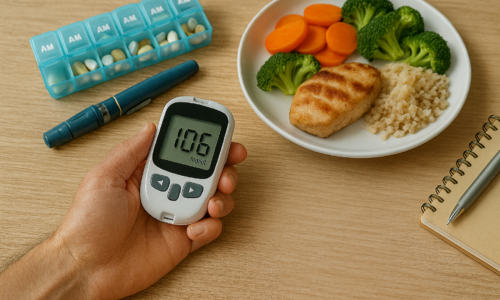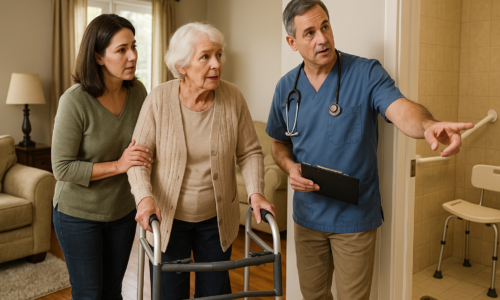Did you know that nearly 20% of older adults discharged after a heart failure hospitalization are readmitted within 30 days, often because early signs were missed at home? That statistic highlights a critical truth: most emergencies don’t appear overnight—they build quietly, day by day, through small warning signs we overlook.
At-home monitoring and timely intervention can shift that story. When daily weights, symptom logs, and home visits work together, the result is fewer hospital readmissions, less stress, and more control. In this article, we’ll explore how to recognize early warning signs of COPD and heart failure, use technology and telehealth to stay connected, and create a proactive plan that helps you or your loved ones remain safe and stable at home.
In a world where chronic care is rapidly evolving and technology is becoming more accessible, learning how to spot trouble before it escalates isn’t just smart—it’s life-saving.
Why Early Detection at Home Matters
When early warning signs go unnoticed, the outcome can be devastating: costly hospital stays, emergency visits, worsening symptoms, and emotional strain for both patients and families. The good news is that most of these escalations are preventable with consistent observation and early action.
Home-based care programs, such as medical house calls and telehealth, have proven to reduce readmissions by identifying small changes before they become big problems. A few minutes of daily tracking can often reveal what hours in the emergency room might miss. Early detection truly is the foundation of better health outcomes—and peace of mind.
Daily Weights and Symptom Logging
Your scale can be your first line of defense. For patients with heart failure and COPD, sudden changes in weight often signal fluid retention or worsening congestion. Weigh yourself at the same time each morning, before breakfast and after using the restroom. A gain of more than two to three pounds within a couple of days may be a red flag worth sharing with your care team.
Beyond the scale, keeping a simple symptom log can be lifesaving. Track breathing patterns, coughing, fatigue, swelling, and any new or worsening discomfort. Note changes in sputum color, the need for extra pillows at night, or increased use of rescue inhalers. These trends help clinicians make early, informed decisions.
Digital health tools make this easier than ever. Many apps or telemonitoring platforms allow patients to log symptoms, sync devices, and automatically alert care teams when readings change. Over time, this data tells a story—a story that can prevent emergencies before they unfold.
Home Visits and Telehealth Support
Nothing replaces the trained eye of a clinician. Home visits bring expert assessment directly to your environment—checking vital signs, oxygen equipment, medications, and even how well you’re using your inhalers or mobility aids. These visits often uncover small but important factors that office appointments can miss.
Between visits, telehealth bridges the gap. Video consultations and connected monitoring devices allow clinicians to review your daily logs, evaluate your weight trends, and spot potential issues in real time. Remote monitoring ensures that you don’t have to face uncertainty alone—help is just a call or message away.
When concerning patterns appear, your care team can escalate promptly with a home visit or treatment adjustment, preventing decline and avoiding unnecessary hospitalization. This continuous connection between patient and provider transforms chronic care from reactive to proactive.
Recognizing Red Flags Before They Escalate
Red flags are your body’s way of asking for attention. For heart failure, that could mean rapid weight gain, swelling in the legs or abdomen, increasing shortness of breath, fatigue, or new difficulty breathing while lying down. For COPD, it may appear as increased coughing, thicker or discolored sputum, chest tightness, or needing to use rescue inhalers more frequently.
Some signs overlap between the two—confusion, loss of appetite, or worsening fatigue can indicate declining oxygen levels or increased fluid overload. The key is pattern recognition. If something feels “off,” document it, check your readings, and contact your care provider before symptoms worsen.
Every patient should have an escalation plan that spells out when to call the nurse, when to adjust medications, and when to seek emergency care. Acting early can make the difference between a simple medication change and a hospital stay.
Creating a Supportive Home Environment
Your surroundings play a big role in managing chronic conditions. Keep your home free from smoke, dust, and allergens that can trigger flare-ups. Ensure oxygen tubing and nebulizer equipment are clean and stored properly. If humidity or temperature affects your breathing, consider using an air purifier or humidifier to stabilize your indoor air quality.
Medication organization is equally vital. Pillboxes, smartphone reminders, or blister packs help maintain consistent dosing and reduce errors. Ask your provider or pharmacist about drug interactions—especially when combining heart and lung medications.
Lifestyle habits reinforce everything else. Following a low-sodium diet, limiting fluids when recommended, and maintaining gentle activity levels all help stabilize your condition. Educate both patients and caregivers so everyone understands how to log data, spot red flags, and respond promptly when needed.
Leveraging Technology to Stay Ahead
Modern technology is reshaping chronic care at home. Smart scales, pulse oximeters, and connected blood pressure monitors can send readings directly to your clinician’s dashboard. Some systems use predictive analytics or artificial intelligence to detect subtle changes that suggest early deterioration—long before symptoms become obvious.
Data integration is key. Your devices should connect seamlessly to your provider’s portal or electronic medical record, creating a continuous feedback loop. This allows clinicians to adjust care plans in real time and personalize recommendations based on trends rather than isolated events.
However, even the best tools require balance. Watch for false alerts, technical issues, or data overload. Choose platforms that are clinically validated and easy to use, and always discuss any new technology with your healthcare team to ensure it fits your needs.
Enhancing the Patient Experience
Ease of use determines consistency. When apps are too complicated or devices confusing, people simply stop using them. A user-friendly design—large buttons, clear visuals, and simple navigation—can make adherence soar.
Performance metrics should focus on what matters most: how often data is logged, how quickly alerts are addressed, and how accurately red flags predict true events. Regular feedback and continuous improvement keep patients engaged and ensure the system evolves with their needs.
Accessibility also matters. Voice input, mobile optimization, and high-contrast text help users with visual or mobility limitations. When patients feel confident using their tools, they’re far more likely to stay consistent—and consistency is what saves lives.
Continuous Education and Feedback Loops
Education transforms monitoring into mastery. Providing patients with quick-read guides, videos, or tip sheets reinforces good habits and builds confidence. Ongoing communication—whether through telehealth check-ins, reminder messages, or educational newsletters—keeps patients and caregivers informed and motivated.
For organizations like At Home Medical Professionals, content plays a major role in engagement. Publishing practical resources, red flag checklists, or success stories helps patients feel supported and understood. Each touchpoint strengthens trust, improves compliance, and enhances outcomes.
Tracking engagement data—how many patients use their logs, open reminders, or schedule follow-ups—offers valuable feedback. This insight helps refine care plans, digital tools, and education materials to keep improving results.
Preventing escalation in COPD and heart failure starts at home—with awareness, consistency, and connection. By tracking daily weights, maintaining symptom logs, and engaging regularly with your care team through home visits or telehealth, you create a safety net that catches problems before they spiral.
Small actions make an enormous difference. Starting today, commit to one: begin your weight log, clean your oxygen tubing, or schedule your next home visit. These steps not only reduce ER risks but also empower you to take control of your health journey.
If you or someone you care for could benefit from proactive chronic-care monitoring, reach out to At Home Medical Professionals to schedule a home visit. Together, we can turn prevention into peace of mind—and ensure that every day at home is a safer, healthier one.



